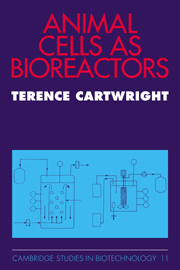Book contents
- Frontmatter
- Contents
- 1 Introducing the animal cell as a bioreactor
- 2 Yields of recombinant product: engineering cells for maximum expression
- 3 Generation of biomass
- 4 Adjusting cellular metabolism for optimum product yield
- 5 Downstream processing
- 6 Regulatory aspects of using cells as bioreactors
- 7 Overview and conclusions
- References
- Index
5 - Downstream processing
Published online by Cambridge University Press: 12 October 2009
- Frontmatter
- Contents
- 1 Introducing the animal cell as a bioreactor
- 2 Yields of recombinant product: engineering cells for maximum expression
- 3 Generation of biomass
- 4 Adjusting cellular metabolism for optimum product yield
- 5 Downstream processing
- 6 Regulatory aspects of using cells as bioreactors
- 7 Overview and conclusions
- References
- Index
Summary
All of the procedures and methods discussed so far concern how animal cells can be grown in quantity and engineered to synthesize the maximum possible amounts of protein product required from them. In this section we turn to the methodologies applied to the recovery of the protein product from the cell cultures and to turning it into an acceptable pharmaceutical dosage form. The whole of this operation is known as downstream processing (DSP).
The inclusion of a section on downstream processing in a discussion of animal cells as bioreactors is fully justified for several reasons. First, it is usually the effectiveness of the downstream processing which determines the economic viability of the process since it accounts for at least 70–80% of the overall costs. Second, downstream processing plays a determinant role in assuring the safety of products derived from animal cells. Finally, the success of the overall production process depends to a large extent on the successful integration of the expression system used, the cell culture system used and the processing methods applied to produce the finished product.
Although they may not always be easy to define, interactions exist between all of these stages, and early evaluation of these greatly facilitates successful process design. Too frequently in the past biotechnology companies have developed new cell systems for producing original products and have then adapted standard purification schemes to suit. How ever, there are potentially great savings in time and cost if process design is performed in an integrated manner, for instance, taking into account before the cell culture system is finalized the impact of medium composition or possible cell lysis on the quality of the product stream going for purification.
- Type
- Chapter
- Information
- Animal Cells as Bioreactors , pp. 112 - 128Publisher: Cambridge University PressPrint publication year: 1994

